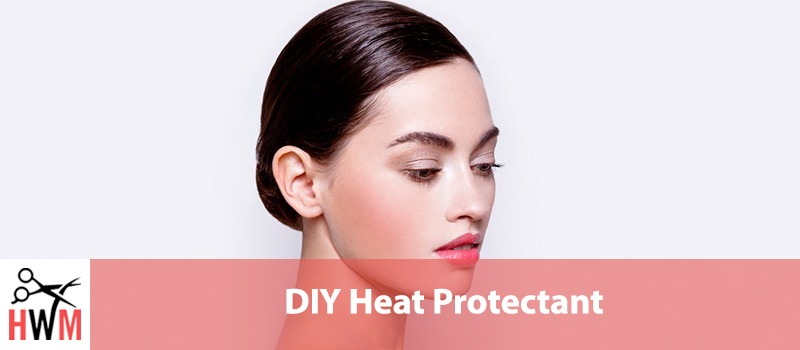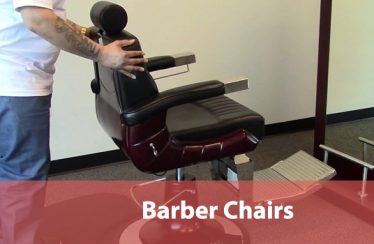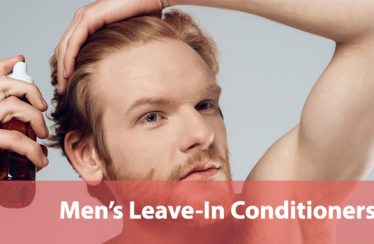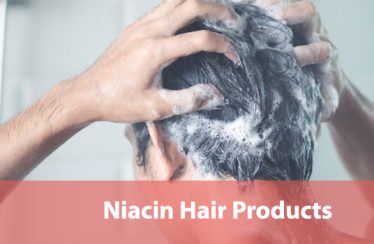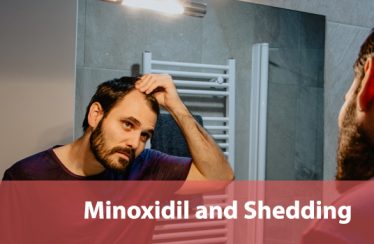Hairdryers, flat irons, hot rollers, and curling irons all work on the same principle, i.e., using heat to make hair more accepting of different styles. Heat can be used to manipulate the natural hydrogen bonds in your hair.
If your hair is curly, the heat from the flat iron will break down its hydrogen bonds, allowing it to be straight. Similarly, if your hair is straight, the curling iron will help your hair form new hydrogen bonds to create curls. Moreover, hairdryers use heat to dry your hair.
Whichever hot tool you use, you’re exposing your hair to heat. A heat protectant, as its name suggests, protects your hair from this heat. It is used as a spray and you can either buy it or make it at home. DIY heat protectants, however, are significantly better than consumer heat protectants.
In this guide, we’ll not only explain why DIY heat protectants are better than consumer heat protectants, but also give you some quick and simple recipes for homemade heat protectants along with some other information about heat protectants. Here is everything you’ll read about in this ultimate DIY heat protectant guide.
- How Does a Heat Protectant Work?
- Why DIY Heat Protectant Is Better Than Readymade Heat Protectant?
- How Should You Use A Heat Protectant?
- DIY Heat Protectants: Recipes
- What Else Can You Do to Reduce Heat Damage for Your Hair?
How Does a Heat Protectant Work?
Before we can understand how a heat protectant works, we need to understand how heat damages hair.
Every hair strand can be divided into two layers. The inner layer is called the cortex and contains water molecules and keratin. The outer layer is called the cuticle.
When exposed to too much heat, the water molecules in the cortex evaporate. This can happen if you expose your hair to too much heat in a single session or through sessions that are too frequent. As water evaporates from the cortex, hydrogen bonds of the hair break. The loss of hydrogen bonds changes the shape and structure of the hair.
However, excess heat also breaks down the keratin inside the cortex. Since keratin is crucial for hair health, this causes hair to become more prone to breakage and makes it look listless, lifeless, and dull.
Heat exposure affects the outer layer of the hair strand as well. It causes the cuticle of the hair strand to rupture and crack, which further affects the appearance of the hair.
Moreover, when this happens, the cortex gets even more exposed and susceptible to heat. A heat protectant can break this cycle of attrition by creating a barrier between the heat and the hair strand.It creates a new coating on the hair strand that reduces the impact of the heat on the hair. This coating seals off the moisture in the hair from the hot tool.
Further, it smoothens and repairs the cuticle and also makes it possible for the heat to be evenly distributed all over the hair strand. Since it ensures uniform heat, it speeds up the straightening, curling, or drying process.
Why DIY Heat Protectant Is Better Than Readymade Heat Protectant?
As mentioned earlier, you can either buy a heat protectant from the market or make your own at home. However, while commercial heat protectants will always be much stronger than homemade heat protectants, the latter is better in most other aspects. What are these aspects? Consider.
DIY Heat Protectants are More Versatile
The primary reason why people choose DIY heat protectants is their versatility. When you make these sprays or creams at home, you have complete control over which ingredients you use.
This is hugely beneficial because you can customize the heat protectant based on your specific hair type. For instance, you can pick moisturizing and conditioning oils if you have very dry hair. Similarly, you can choose nourishing and strengthening oils, if your hair is brittle, damaged, or over-processed.
DIY heat protectants’ versatility extends beyond the type of ingredients you choose too. You can vary the strength of the heat protectant and even change their fragrance as per your specific preferences by increasing or decreasing the quantity of specific ingredients.
DIY Heat Protectants are Natural
Another important difference between DIY and commercial heat protectants is that the former can be all natural. In fact, most DIY heat protectant recipes tend only to include natural ingredients.
They’re free of all artificial chemicals and compounds which makes them suitable for people with sensitive scalp and skin. Moreover, since their ingredients are chosen by the users themselves, DIY heat protectants are also great for people with allergies.
DIY Heat Protectants are Cheaper
DIY heat protectants also turn out to be significantly cheaper than commercial heat protectants. You can probably get a DIY heat protectant for a quarter of the cost of a commercial heat protectant.
Further, not only are DIY heat protectants cheaper, but they also offer more value for money. You’ll get more benefits from a homemade heat protectant than you would from a commercial heat protectant.
How Should You Use A Heat Protectant?
It is very easy to use a heat protectant. Here are the steps.
- Wash your hair and let it dry till your hair is only damp.
- Spray the heat protectant onto your hair. You don’t need to focus on the roots so much. Make sure that you spray the entire length of your hair, though.
- Don’t spray too much of the heat protectant as that will weigh your hair down and make it look limp and lifeless. Further, it will interfere with the curling or straightening process. You only want to coat the hair lightly.
- You have to wait a few minutes to let the heat protectant dry. If you hear a sizzle while using a curling iron or flat iron, then you didn’t wait long enough. This will make your hair smell bad and may even cause damage.
- Once the heat protectant is dry, you can safely use your hot tool.
DIY Heat Protectants: Recipes
DIY heat protectants are usually based around naturally occurring oils, but they can incorporate commercial products too. Further, depending on your specific requirements, your DIY heat protectant can contain one or more ingredients.
We have included several DIY heat protectant recipes in the following section. While you can try any or all of them, we suggest choosing on the basis of your specific hair type and requirements.
Plain Oil as Heat Protectant
The simplest DIY heat protectants are a mix of water and natural oil. You don’t need to mix them in any particular ratio, but you shouldn’t go beyond 1:5 where one is oil and five is water.
This means that you shouldn’t use more than 1.3 ounces of oil if you have 6-7 ounces of water. At the same time, it is likely that you’ll have to vary this ratio anyway to suit your specific requirements.
You will have to consider two variables while tweaking the ratio.The first is the type of your hair. Dry, thin hair will require more conditioning so you can stick to this ratio. However, if you already have oily hair, then you’ll want to tone down on the oil side of the mix.
The ratio will also change based on the type of oil you’re using. Different oils have different consistencies. Some are thicker and heavier, which means you can’t use too much of these types of oils in your DIY heat protectant.
You may want to change the ratio to modify how strong the smell of your DIY heat protectant is as well. We should also add that oil and water don’t really mix well. So, if you use this recipe, you’ll want to shake your DIY heat protectant well before every use.
Here are a few oils that will do particularly well in this kind of DIY heat protectant recipe along with their respective properties.
Coconut Oil
Coconut oil is a panacea for all hair-related ills. It has been used to protect and nourish hair since ancient times, but in recent years numerous studies have ended up proving its qualities. Here are a few.
- It is a great moisturizing and conditioning agent.
- It nourishes hair and boosts growth rate.
- It repairs damaged hair cuticles.
- It is an anti-infection agent.
- It resolves dandruff, flaky, and scaly scalp.
- It adds luster and shine to hair strands.
- It cools and soothesthe scalp.
If you choose to use coconut oil as your DIY heat protectant, you may have to melt it. Coconut oil has the unique property of being solid at room temperature.
Also, make sure that you don’t spray your hair with too much of this heat protectant. Coconut oil can really weigh down the hair in large amounts. For this reason, coconut oil is better suited to people with dry hair than those with oily hair.
Further, if you have thick, coarse, and curly hair, you should avoid coconut oil because it won’t be able to handle the high temperatures you need to style your hair.
Argan Oil
Argan oil, like coconut oil, was used to maintain hair by multiple ancient civilizations. It is even referred to as “liquid gold” because of its qualities.
Argan oil grows naturally in Morocco which is why Moroccan argan oil is considered to be the best. Black argan oil, incidentally, is a stronger version of the golden argan oil. It is more effective but also more acidic and more expensive.
- It is an excellent moisturizing and conditioning agent.
- It tames frizz and adds shine to hair.
- It nourishes hair because it is rich in antioxidants, vitamins, and minerals.
- It eliminates dandruff along with flakes and dry cells from the scalp.
- It makes hair shiny and vibrant.
- It has a high smoke point.
Argan oil is often used as a deep, leave-in conditioner because it has such strong moisturizing qualities. However, this also means that you can’t use too much of it or it will start weighing down your hair and making it very greasy.
Almond Oil
Almond oil sees a regular prescription in alternative medicine like Ayurveda for a wide variety of problems. It is particularly useful for women who have brittle, damaged, or over-processed hair. Further, it is good for women with oily hair since it gets absorbed easily and doesn’t make the hair greasy.
However, this oil is derived from almonds, which is a type of nut. If you have nut allergies, you shouldn’t use this oil in your DIY heat protectant. Here are some benefits of almond oil.
- Its components fill gaps in hair structure, making them stronger and more resilient.
- It has a very high smoke point.
- It softens hair.
- It repairs split ends.
- It works against dandruff and flaky skin.
- It has deep conditioning properties.
- It makes hair shiny.
Grapeseed Oil
As its name suggests, this oil is derived from grape seeds. Many people view grapeseed oil as the best oil to use in a DIY heat protectant because it is suitable for all hair types. It is as beneficial for weak and brittle hair as it is for thick, coarse, and curly hair. Here are some of its qualities.
- It is an excellent moisturizer and conditioner.
- It combats dermatitis and dandruff.
- It slows down DHT production in the body.
- It has a high smoke point.
- It contains vitamin E and linoleic acid.
- It is easily available.
Sunflower Oil
Sunflower oil is very similar to grapeseed oil. They are both used for cooking and they both have very high smoke points. Since sunflower oil can handle high temperatures so well, it is an excellent heat protectant for women with thick, curly, and coarse hair. The following are some of its qualities.
- It has a high smoke point.
- It is an excellent moisturizer and conditioner.
- It contains multiple nutrients beneficial for hair growth.
- It is a very effective emollient.
- It is alightweight oil.
Shea Butter
Shea butter can be an excellent heat protectant. The only challenge with using shea butter is that it is not liquid. Instead, it is always in a semi-solid state. As a result, you can’t really turn it into a spray by mixing it with water.
To turn it into a spray, you’ll have to mix it into a carrier oil like coconut or argan oil. However, you can use shea butter as it is if you’re willing to apply it like a hair cream.
You’ll be able to benefit from its numerous qualities, regardless of whether you use it as it is or mixed with a carrier oil. Here are some qualities of shea butter.
- It moisturizes and conditions hair excellently.
- It repairs follicles and hair strands equally well.
- It contains multiple nutrients that strengthen hair and encourage new growth.
- It counters dandruff and infections.
- It has a high smoke point.
Avocado Oil
Avocado oil is an excellent heat protectant for people with thick, curly hair because it has one of the highest smoke points amongst all oils. It is also an excellent option for women who spend a lot of their time outside in the sun.
It is even great for women with brittle hair because of its enriching qualities. Here are some of its qualities.
- It has a very high smoke point.
- It is a very lightweight oil.
- It can penetrate deep into the hair shaft.
- It is great for people with extra-dry scalp.
- It offers protection from ultraviolet rays.
- It counters dandruff and infections.
The only problem with avocado oil is that it is very pricey. However, since you’ll be using it as a heat protectant, you won’t need a lot of it. This will make the cost of avocado oil much more palatable.
Peppermint Oil
You’ll find peppermint oil in several haircare products. The main reason for this is its smell. Very few people dislike the minty smell it imparts. In fact, most people will choose to make their heat protectant with peppermint oil for this reason alone. However, it has multiple other benefits too.
- It increases blood circulation in the scalp.
- It reinvigorates hair follicles.
- It is an antimicrobial agent.
- It prevents lice.
- It is an anti-inflammatory agent.
- It is soothing for the scalp.
Because of the way peppermint oil helps strengthen hair follicles, it can be a particularly useful heat protectant for people with thinning hair.
Essential Oil DIY Heat Protectant
This recipe for DIY heat protectant is one of the most versatile because you can choose from all types of essential oils out there.
What You’ll Need:
Step-by-step Procedure:
- Fill the glass bottle with about 3-4 ounces of water.
- Add about 0.33 to 0.50 ounces of coconut oil (melted) to the water.
- Add around 0.33 to 0.50 ounces of almond oil to the mix.
- Drop approximately0.20 ounces of your favorite conditioner into the mix.
- Drop approximately 15 to 20 drops of your chosen essential oil into the mix. You can add more or less depending upon your preferences.
- You can use any type of essential oil you prefer. You can also choose on the basis of their qualities. For instance, peppermint oil is great for thinning hair, rosemary oil is good for oily hair, and geranium oil is great for dry hair. You can use lavender oil if you don’t have specific requirements.
- Shake the mix well.
- Add the rest of the water and shake the mix again.
- Remember to shake it before each application. Spray on hair lengthwise without overdoing it.
Avocado DIY Heat Protectant
Avocado oil is very much a complete ingredient. You don’t really need to put multiple other ingredients into an avocado heat protectant, but if you choose to, it will only make the heat protectant better. Here’s how you can do this.
What You’ll Need:
- Fill up the spray bottle with about 5-6 ounces of water.
- Add approximately 1-2 ounces of avocado oil into the water.
- Add up to five drops of your favorite essential oil.
- Seal the bottle and shake it well immediately and after every use.
Conditioner DIY Heat Protectant
If you have especially thick, coarse, and curly hair, you may want to use a conditioner DIY heat protectant. While you can use any conditioner, we suggest choosing from those that have silicones in their ingredients list.
Silicones are the best when it comes to coating hair shafts and protecting them from heat damage. In place of a conditioner, you can also use a commercial heat protectant, hair serum, or hair mask too.
What You’ll Need:
- Put about 5-6 ounces of water in the glass spray bottle
- Add about 15 drops of melted coconut oil to the water.
- Add approximately five drops of almond oil into the mix.
- Add around 2 ounces of your chosen conditioner or hair product containing silicones. You can’t have the mixture too thick, so modulate the amount as required.
- Shake the mixture well and add the rest of the water.
- Shake the heat protectant vigorously before every use.
Aloe Vera DIY Heat Protectant
Aloe vera is very healthy for hair. However, you can’t really use raw aloe vera for several reasons. The foremost is that raw aloe vera is very sticky. Another is that it doesn’t smell very nice. Therefore, if you want to reap the benefits of aloe vera, you’ll have to use aloe vera gel. Here’s the recipe.
What You’ll Need:
Step-by-step Procedure:
- Warm about three ounces of water. Don’t overheat it. You only need it warm to ensure proper mixing.
- Drop the aloe vera gel in the warm water and stir thoroughly. The objective is to make sure that the aloe vera gel is mixed properly. You don’t want to see any lumps floating around.
- Add coconut oil into the mix and stir thoroughly again. If your hair is very dry, try almond oil in place of coconut oil.
- Pour the mix into the spray bottle.
- You can mist your hair with this heat protectant before using any heat tool. Make sure that you shake the bottle thoroughly before doing this though.
Shea Butter DIY Heat Protectant
Shea butter is an excellent heat protectant on its own, but if you augment its qualities, it can be one of the best. You can enhance its qualities by adding other oils to it. You can add any oil to shea butter, but make sure that the one you choose is right for your hair type. We’re going to use avocado oil because it suits almost everyone. Here’s the recipe.
What You’ll Need:
Step-by-step Procedure:
- Warm the shea butter. Don’t melt it completely. You just want it soft, semi-solid, and malleable.
- Whip the shea butter till it is light and fluffy. You can also blend it for the same results.
- Add avocado oil to the fluffy shea butter and whip it again.
- Add your choice of essential oil and whip it again
- Transfer the mix into the glass jar and put it in the refrigerator or ice to bring it to room temperature. It must not freeze.
- You’ll need to apply this DIY heat protectant like hair cream instead of spraying or misting it on.
What Else Can You Do to Reduce Heat Damage for Your Hair?
A good heat protectant is vital if you want to reduce heat damage. However, it isn’t the only way to do this. There are other steps you can take to safeguard your hair from the heat of your hot tools.
In fact, just relying on the heat protectant may not be enough and your hair may end up showing signs of damage anyway. So, what else can you do to protect your hair? Here are some tips.
Avoid Using Hot Tool on Unwashed Hair
Unwashed hair could contain product buildup, dead skin cells, grime, dust, and even the natural oil produced by your hair follicles. More importantly, these things won’t be evenly spread on your hair and would be found in clumps instead.
Therefore, when you start using a hot tool on unwashed hair, different parts of your hair will receive different amounts of heat. When your hair doesn’t respond to the styling, you’ll try to compensate with multiple passes and this will cause heat damage to your hair.
Use A Smoothing Shampoo
Smoothing shampoos are very useful for women who style their hair regularly. These shampoos contain silicones and other polymers that leave a coating on your hair even after you’ve rinsed it.
This coating does two things. The first is that it protects your hair from heat damage. The other is that it makes your hair more responsive to styling.
You could use these shampoos with the heat protectant or without. However, we do recommend using a less oily heat protectant if you plan to do this.
Never Use Hot Tool on Wet Hair
You must never use a hot tool on dripping-wet hair. The excess water will fry your hair very quickly. Therefore, before you start with a hot tool, remove all excess water.
Do this by wringing your hair dry, shaking it dry, letting it air dry, using a microfiber towel, or just wearing a microfiber hair cap. At most, your hair should be damp when you’re using a hot tool.
Minimize the Use of Hot Tools
The simplest way to reduce heat damage for your hair is to reduce heat exposure. Use your hot tools less and you will automatically reduce heat damage.
Change your schedule so you can let your hair air dry. Use a paddle brush with the ancient “100 strokes” technique to straighten your hair. Try non-heat hair curlers.
Get A Hot Tool with The Latest Technologies
Most women, however, won’t have the time needed to style hair without heat. If you’re one of these women, at least, make sure that your hot tool has the latest technologies. Never buy or use any hot tool without ceramic technology. Consider ionic and infrared technologies as well.
Style Your Hair at The Right Temperature
You don’t always have to use the maximum temperature of your hot tool to style your hair. Anything above 400 degrees Fahrenheit is usually for women with extremely thick, curly, and coarse hair. It is likely that you’re not one of them.
Therefore, the right temperature for you is definitely below 400 degrees Fahrenheit. Get a hot tool with multiple temperature settings so you can find the ideal temperature for your hair type. Better yet, go for tools with variable heat settings.
When using the tool, start at lower temperatures and increase them gradually until you find a happy balance between the amount of heat you use and the speed with which your hair styles.
Always Keep the Hot Tool Moving
Never keep the hot tool in one spot on your hair or even pause for more than a second or two. Naturally, this will lead to excess heat exposure for the section unfortunate enough to be under the spotlight over an extended period of time. Always keep the hot tool moving to reduce heat damage.
Never Style A Hair Section More Than Once
This hairstyling rule is common knowledge in professional circles: “one and done.” It means that you don’t use the hot tool on a section more than once. You shouldn’t give a section multiple passes as that will double the amount of heat it receives.
Initially, this will be difficult for you because it means finding the right styling speed. However, if you persist on following this rule, you’ll be able to manage after only a few tries.
